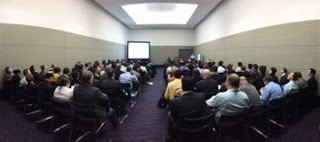 We hosted a structural varation workshop at the annual meeting of the American Society of Human Genetics, and were pleased to see that the speakers’ presentations
We hosted a structural varation workshop at the annual meeting of the American Society of Human Genetics, and were pleased to see that the speakers’ presentations
really resonated with attendees – the event was standing-room-only!
Jonas Korlach, PacBio CSO, opened the session by sharing a brief update
on SMRT® technology, noting that the new P5-C3 chemistry delivers 50% of bases in 10 kb or longer reads. View presentation recording
Evan Eichler, Howard Hughes Medical Investigator from the University of Washington discussed his use of the PacBio® system to study difficult-to-sequence regions of the human and chimp genomes. Eichler has identified a number of rapidly evolving hot spots in the human genome that are associated with disease. These regions are quite long and have extremely repetitive DNA sequence, making them difficult to elucidate with short-read sequencing and very expensive to interrogate with Sanger sequencing. Eichler’s goal is to fill in the missing regions of the human genome reference, many of which contain segmental duplications. He spoke about a region on human chromosome 17, where duplications were more than 98 percent identical, which he sequenced using the PacBio platform to an average read depth of 200x with eight BACs (one BAC per SMRT Cell). All but one BAC assembled automatically into a single contig, and the final assembly quality was better than Q45, Eichler said. He also discussed his collaborative work with PacBio to generate 10x coverage of the human genome; that data set was publicly released last month. With the approaches he discussed, he said, “I think we can recover the regions that are missing in most genomes.” View presentation recording
Ali Bashir from the Icahn Institute for Genomics and Multiscale Biology at Mount Sinai spoke next, presenting human genome data on other challenging regions. He described a tool to detect tandem repeats (PACMonSTR – preliminary version available soon), which he believes are dramatically underrepresented in the human genome reference but that can be discovered with PacBio sequencing. In a collaboration with Cold Spring Harbor Laboratory and Cornell, Bashir and his team also generated shotgun, whole-genome sequence data from human genomic DNA using PacBio sequencing. Their goal was to find structural variation features that are not present in the existing reference. He showed numerous examples wherein the long PacBio reads were able to resolve inversions in the sample, relative to the reference, and define structural variation breakpoints. Compared to short-read sequence, Bashir said, “the mappability of each individual [PacBio] read is much better.” View presentation recording
Our own scientist Swati Ranade also spoke at the workshop, presenting recent efforts to look at challenging regions of the human genome using SMRT Sequencing. She highlighted a study just published that fully sequences a particular mucin gene for the first time, as well as work on KIR haplotypes in humans and other primates. View presentation recording
We are glad to see these new applications of PacBio sequencing to the human genome, and look forward to many other examples in the future.